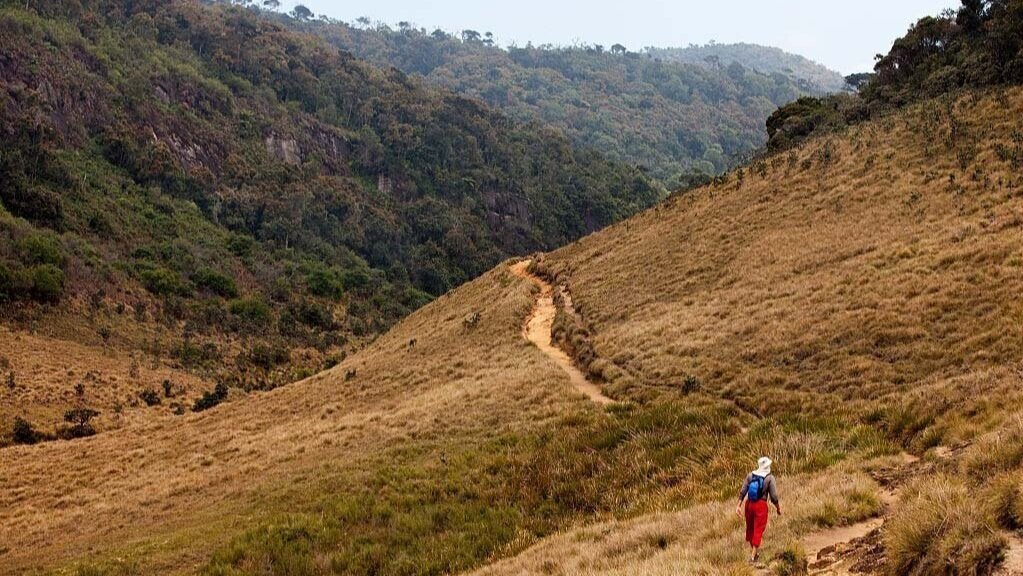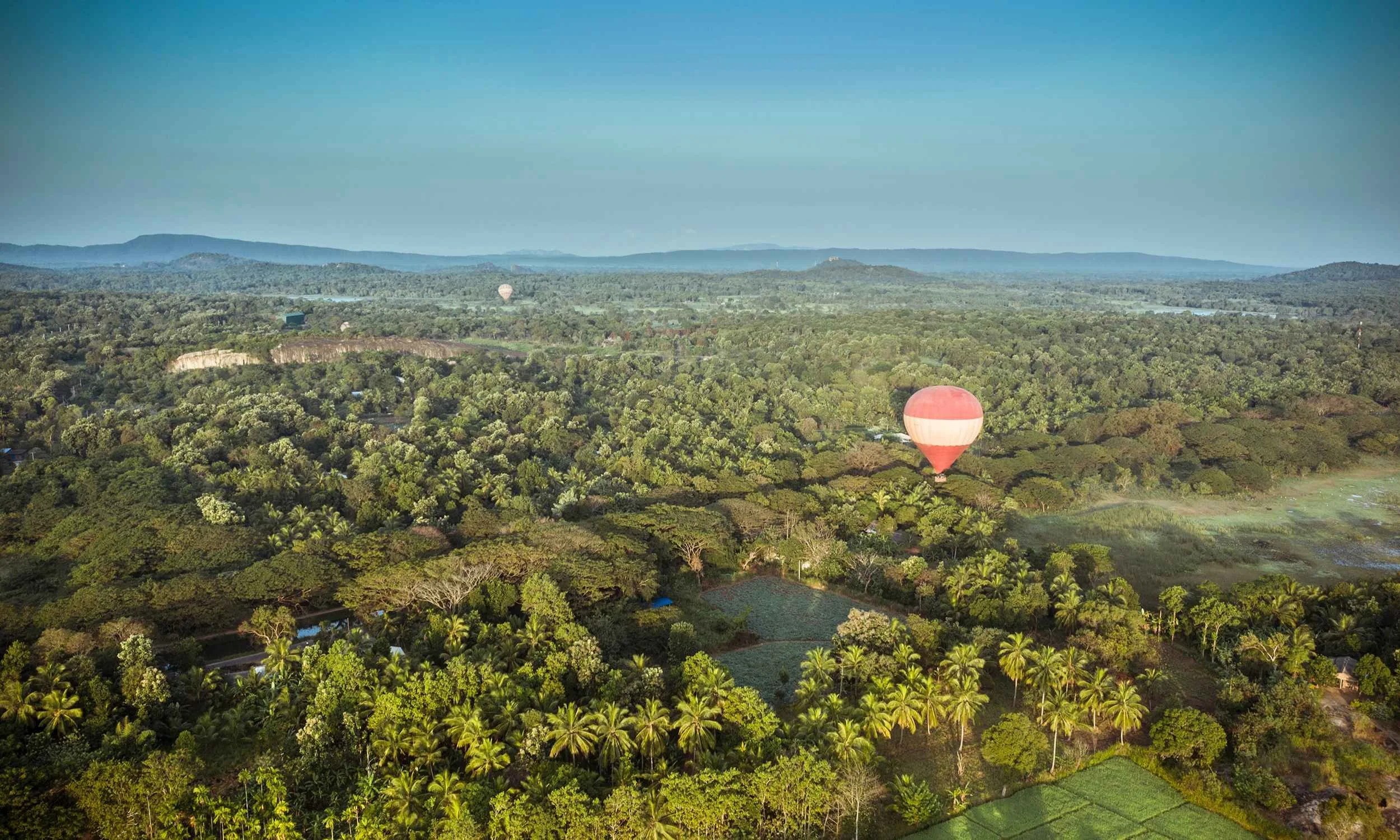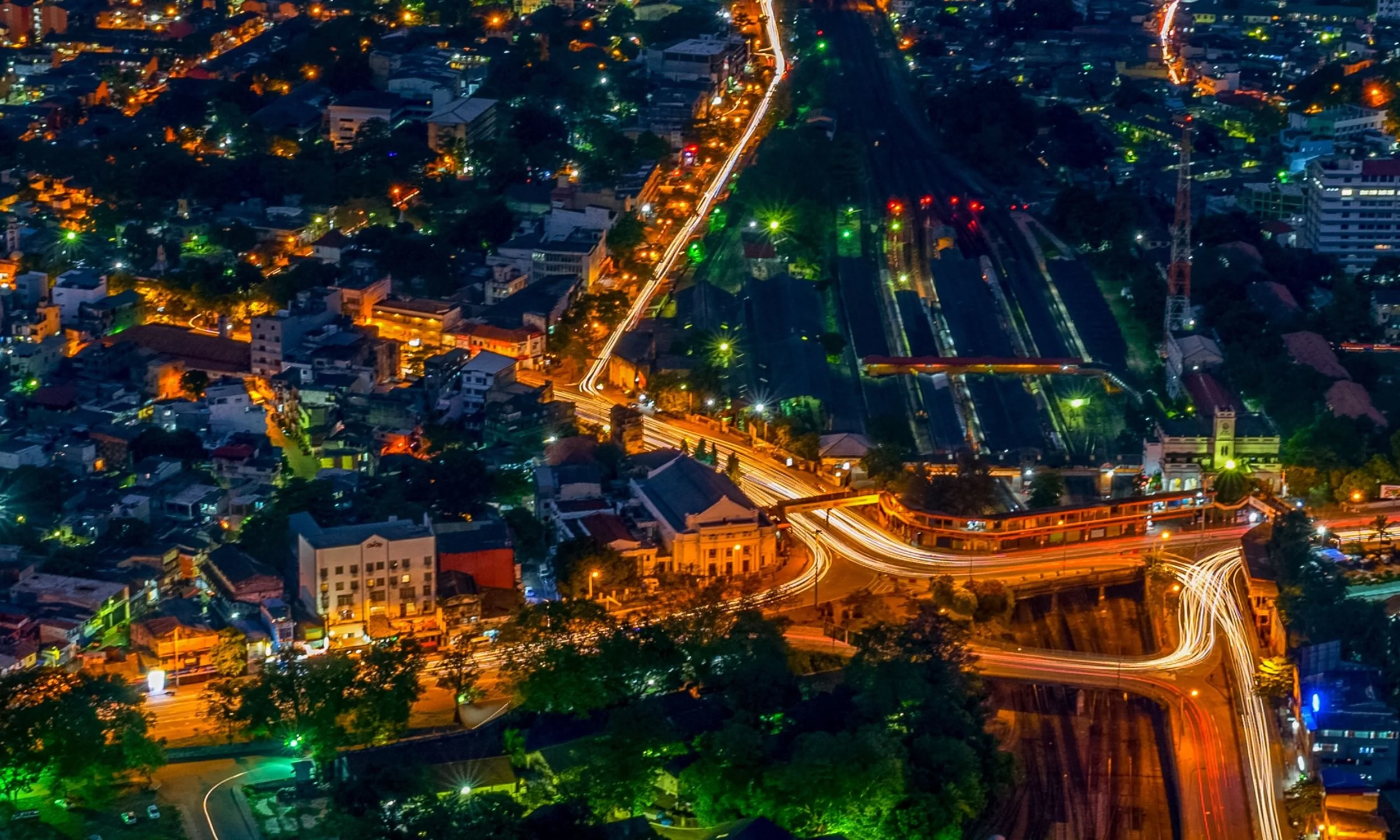Soul-Tugging Hiking Scenery in Horton Plains National Park Sri Lanka
© Damith Danthanarayana
There’s no such thing as a bad day when you’re hiking Sri Lanka’s most famous mountains and plains with an extremely knowledgeable Naturalist.
Is it the stories of the reds and mustards on the grasslands or every shade of green hue in the thick forests; is it the sharp ear that hears the call of wildlife in the far horizons or the quick eye to spot two tiny endemics flitting around in the mist-filled surreal surrounds. There is something about Horton Plains National Park in the friendly company of an insightful Ayu in the Wild Naturalist that offers visitors a unique adventure - call it an undiluted connection to the pristine wilderness in Sri Lanka. It makes waking up a long time before dawn, absolutely worthwhile.
Break of Dawn On those Epic Mountains in Sri Lanka
© Jet Laggies
The island is barely shrugging off its sleep.
You’re on a holiday to Sri Lanka. Must you awake before dawn has awoken?
The snack packs are ready and your cheery greeting with the Naturalist and Chauffeur sets of a puff of breath, clearly visible in the crispy air. It’s quite cold still and layers will help you keep warm for the first hour or two of this amazing journey on mist covered roads navigated expertly by a Chauffeur. If you are traveling from Nuwera Eliya, we recommend leaving by 5 am for your journey to Horton Plains to reach the perfect spot to witness 6 am sunsrise. As you enter one of the Central Highland’s UNESCO World Heritage Sites towards the best Sri Lanka hiking mountains, the scenery jolts you. The night shades are barely streaking away and the sun hasn’t fully penetrated the clouds and there, spread out ahead as far as you can see, are the barely discernible silhouettes of Horton Plains, and nearby, that unmistakable fresh smell of morning dew still resting on the reeds.
It’s not uncommon to see well fed Sambar bucks and does and maybe even a majestic stag with its beautiful antlers gazing at dawn visitors. The grasslands of Horton Plains are home to flourishing herds of Sri Lanka’s largest deer. More rare, almost impossible would be to see Leopard, but two lucky guests of Ayu in the Wild in fact saw two in early 2020, just as they reached the Horton Plains on their outdoor adventure across Sri Lanka just before the corona-virus pandemic hit the island’s shores.
Ever Wondered About the Origins of Fountains in the Cloud Forests?
The clouds swirl and sunshine fills the plains.
Each time you stop and see nothing but miles of flat land, the surprising snippets of insights by our Naturalists will make you zone out for a few minutes.
Cloud forests behave in a peculiar way. Their water is essentially absorbed from air than from soil. The warm air is filled with humidity blown across the plains that hits the high mountain ranges, rises and makes those thin layers of clouds. Clumps of thin layers, gather into larger clouds which are carried away by the winds until they fall back down to earth as rain. Fog and clouds keep these forests moist and that’s when the fountains start.
Moist roots and soil start to release water and there starts the origin of fountains inside the cloud forests. From the air, to moisture that form into small streams, merrily trickling along until they join together in the most beautiful waterfalls and swamps. Horton plains is considered as the most important watershed area in Sri Lanka. Three major rivers in Sri Lanka; the Mahaweli, Kelani and Walawe rivers, start from Horton Plains. When cloud forests breath and air-moisture morphs into clusters of fountains from the forest’s roots and soil, that then morph into meandering larger rivers, they become the soul food for man and every living creature.
Why Horton Plains Was Designated a UNESCO World Heritage Site in Sri Lanka
Have you ever wondered what it would feel like to see the end of a 2000 metre plateau and an 880 metre drop at the edge! Mind blowing isn’t it? As astounding as it may be, a hike inside Horton Plains is much more than this sheer drop that is famously known as World’s End.
Sri Lanka's Central Highlands are a trio of mountainous regions that forms one of the island’s natural UNESCO World Heritage Sites. Stunning, dramatic vistas welcome visitors to the south central part of the island with the Peak Wilderness Protected Area, the Horton Plains National Park and the Knuckles Conservation Forest making up the Central Highlands and are must visit places for trekking in Sri Lanka.
What makes these montane forests that rises 2500 metres above sea-level a super biodiversity hotspot? Be mesmerized about the extraordinary range of flora and fauna, as an Ayu in the Wild Naturalist makes this 4 to 5 hour trek inside Horton Plains come alive with snippets of several endangered species such as the western-purple-faced langur, the Horton Plains slender loris and the Sri Lankan leopard. Feel awed that you are walking through the only habitats of many threatened plant and animal species on the island, learn about the extraordinary levels of endemism! You might even be distracted tracking several troops of the intriguing purple-faced langur.
Endemism in the Peak Wilderness UNESCO World Heritage Site in Sri Lanka:
Of the 408 species of vertebrates 83%of indigenous fresh water fishes and 81 % of the amphibians in Peak Wilderness Protected Area are endemic.
91 % of the amphibians and 89% of the reptiles in Horton Plains are endemic.
64% of the amphibians and 51% of the reptiles in the Knuckles Conservation Forest are endemic.
How to get to Horton Plains
Horton Plains National Park is just perfect for those who love holidays with outdoors and hikes. Considered as one of the most famous sites for trekking in Sri Lanka, the dreamy cloud forests are located in the Central Province, and is just a one-hour drive from Nuwera Eliya. The phenomenal feature at the Horton Plains is the World’s End where the plateau comes to an end and drops 880 metres in a sheer vertical drop. Horton Plain with Ayu in the Wild starts at 5 am to reach the park around 6 a.m for mesmerizing views of the sunrise.
What You Will See in Horton Plains
Hiking in Horton Plain is generally a 9.5km loop and on average takes around 3 to 4 hours. A small natural pool known as ‘Aranga Wala’ is a perfect spot for avid bird watching enthusiasts as endemic birds like the Sri Lanka Whistling Thrush, Sri Lanka Bush Warbler, Sri Lanka Wood Pigeon and Yellow Browed Bulbul can be frequently spotted. The neck of the loop gives way to two pathways. The one on the right is recommended as it offer greater shade at mid-day with its thick forests leading to the incredible World’s End escarpment and Mini World’s End and a visit to the lovely Baker’s Falls.
The same ticket issued for the Horton Plains trek could also be used to climb Kirigalpotta (2,390 metres), Sri Lanka’s second highest mountain just 185 metres shy of the highest mountain Piduruthalagala. Kirigalpotta is a 7-8 hour trek and approximately 7 Km one way with a steep rock face to clamber over at the final ascent to the summit. The view from Kirigalpotta is just magnificent on a clear day over the Horton Plains, the Thotupola kanda - Sri Lanka’s third highest peak (2,360 metres) that can be scaled on a hike to Horton Plains, and even of Adam’s Peak. Visitors can also explore Thotupola Kanda, a few hundred meters before the park entrance - a short trek of about 5 Km will lead you to a small communication tower at the summit with breathtaking scenery all around.
Insights Into Horton Plains On a Trek With An Ayu In The Wild Naturalist
Ever wondered whether you need a Guide to visit the Horton Plains?
Exploring the saddle-shaped plateau of grassland that makes up the 31 square kilometres of the Horton Plains with a Naturalist from Ayu in the Wild, is a wonderful look at a fascinating landscape that separates Sri Lanka’s second and third highest mountains and life that dwells within it.
The 24 species of mammals, 87 species of birds, 9 species of reptiles and eight species of amphibians. Due to the constant water supply from mist, rains, myriad water holes dotting the Plains and slow moving streams, the Horton Plains is a perfect habitat for amphibians. You will learn insights about the photogenic sambur deer - of which there is a huge population inside the Horton Plains; the eurasian otter (Lutra lutra), grizzled giant squirrel (Ratufa macroura), red slender loris also known as the Horton Plains loris (Loris tardigradus nycticebodies), rusty spotted cat (Prionailrus rubiginosus) and purple faced leaf monkey (Semnopithecus veltus monticola). Six endemic reptiles have been identified in the park including the rhino horned lizard.
The wonderful half day of hiking with Ayu in the Wild will be interspersed with snippets of both historical and pre-historical fact, folklore and legend; about the threats posed to the life and habitats through global warming, non local species of fish and how flora in dense forests adapt to fight for the sparse shards of sunlight.
Known for its rich biodiversity, Horton Plains is home to 5% of the island’s endemic flora, while around 750 different species of plants have been recorded inside it, from ferns, to lichen and orchids on the barks of trees. About 16 different endemic orchid species have been found in Horton Plains which you will spot as you explore the plateau, it's grasslands interspersed with patches of dense montane cloud forests and spots of Dwarf Bamboo near water.
Horton Plains is featured on the bird watching tours in Sri Lanka with Ayu in the Wild for its 12 endemic bird species including the beautiful Sri Lanka blue magpie (Urocissa ornate), dusky blue flycatcher (Eumyias sordidus), Sri Lanka white eye (Zosterops ceylonensis), Legge’s flowerpecker(Dicaeum vincens) and the Sri Lanka whistling thrush (Myophonus blighi). Horton Plains National Park is also home to an extraordinary spectacle known as the “Mix Species Feeding Flocks” where, several insectivorous bird species forage together as one flock.
Where To Stay Near Horton Plains
Goatfell, Kandapola
Feel the warmth and up country charm of a bygone era on a perfect boutique escape perched high up on a hill in the middle of the Concordia estate. Goatfell has everything right about it. Surrounded by neatly trimmed tea bushes near Nuwara Eliya this beautiful, tastefully converted tea estate bungalow belonging to the Teardrop Collection is where Gourmet food and exceptional butler service vie for attentions with jaw dropping views from the infinity swimming pool.
Exploring Horton Plains National Park from Goatfell : its a long drive of just under 2 hours but certainly doable if you are staying for longer than 2 nights.
Ferncliff Bungalow, Nuwera Eliya
A beautiful heritage bungalow on a charming and idyllic slice of Nuwara Eliya where time slows down. Wander around the two and a half acre land and and let your mind drift to the 1800’s when Fercliff was originally built. It has been lovingly restored to its former glory by its owners who have for generations owned the Bungalow. With its incredibly central location surrounded by Ceylon tea, mountainous trails, and to one of the oldest golf clubs in Asia, Ferncliff is one of a kind with oodles of charm and Sri Lankan authenticity thrown in.
Exploring Horton Plains National Park from Ferncliff : A perfect base to explore Horton Plains with a 1 hour drive from Ferncliff at 5 am taking you to the most amazing sunrise moment near Horton Plains by 6 am.
Grand Hotel Nuwara Eliya
The Grand Hotel is heritage luxury in 19th century Edwardian style.
An iconic landmark in Sri Lanka cradled amidst acres of calm and beautiful scenic grounds. Every inch of this luxury retreat has been thoughtfully renovate to preserve its heritage from a bygone era balanced with every modern convenience of a luxury hotel. A swim in its temperature controlled indoor swimming pool is the perfect welcome you need from a hike through Horton Plains.
Exploring Horton Plains National Park from the Grand Hotel : A heritage hotel close to Horton Plains just an hour away from the UNESCO World Heritage Site.
Jetwing Warwick Gardens, Ambewela
A 5 bedroomed haven of highland luxury, lavishly furnished in Edwardian style. A former home of a Scottish tea planter Jetwing Warwick Gardens is an escape which must be savoured.
Exploring Horton Plains National Park from the Warwick Gardens : The closest luxury hotel an hour away from the UNESCO World Heritage Site of Horton.
FAQ’s About Horton Plains
What is the best time of day to start a hike in Horton Plains?
Leave by 5 am from Nuwera Eliya. Hikes that start between 5:30am to 7:00 am are best, for wonderful views of the sunrise.
Should you hire a guide?
To really connect with the pristine wilderness and get the most fascinating insights into the landscape and challenges to the rich biodiversity, you should explore Horton Plains with a guide.
What should you pack for a trek to Horton Plains?
A hat, a pair of good walking shoes, an umbrella or poncho, water and a packed breakfast. A jacket would help during the cold early morning hours. Ensure you carry a small backpack with you.
Are there any rules to be aware?
Just like any other National Park you must not possess any polythene, plastic water bottle labels, disposable food carriers, lighters, cigarettes, alcohol, drones, and pets when entering the park. Littering and lighting fires are strictly prohibited.
Collecting live or dead animals, eggs or parts of animals, live or dead trees, are all prohibited.
Is it possible to take kids on this trek?
Young infants even less than one year of age can be brought along in a suitable carrier preferably strapped on to a parent. However, you must be mindful that rain can be expected in the cloud forests more often than not - therefore appropriate care must be taken when exploring Horton Plains with children,
The presence of leeches or any other bugs or insects to be aware of?
Luckily there are no leeches or mosquitoes to worry about in the park, but there may be other flies or bugs.
Are there any shops to purchase snacks and rest?
There are small shops that sell snacks as well as gift shops at the entrance to the National Park but there are no cafe’s or shops along the hike.
Are there restrooms and toilets?
There are restroom facilities at the ticket office at the entrance, along the hiking route near Bakers Fall water fall and near Mini World’s End.
Other Tips for Hiking in Horton Plains National Park
Bring local currencies in change to buy park permits.
Carry a flask of coffee and some snacks to enjoy during the trek.
Look out for wildlife! Keep an eye out for leopard pug marks and other smaller cats along your route, the purple-faced leaf monkey on tree tops, and listen to the bird calls from the mix species of feeding flocks and identify them.
Use a waterproof casing or bag to keep your camera and accessories dry and safe in case of rain.
Essential to wear layers or a jacket and a thick cap/beanie to keep you warm in the early morning hours.

























